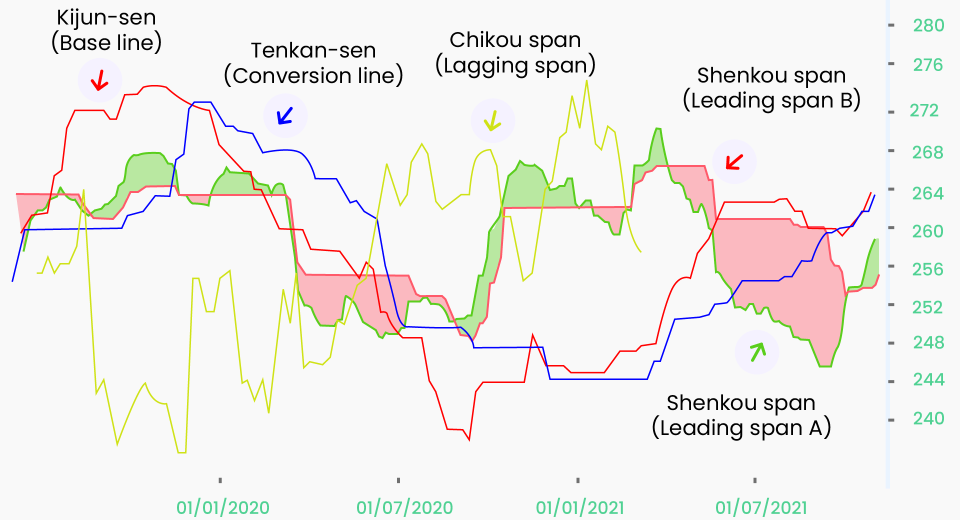A Beginner’s Guide to Using Moving Averages

Moving averages (MA) are one of the most popular indicators used for technical analysis by traders across trading instruments. The various forms of MA can eliminate the noise from price charts and smoothen the data for easier pattern or trend recognition.
Here’s a deep dive into the types of moving averages and how they are used to make informed trading decisions.
Three Types of Moving Averages
Various types of moving averages are:
- Simple
N-period simple moving average (SMA) is calculated by adding the average prices for the N durations under consideration and dividing it by N.
SMA = (A1 + A2 + ……….AN) / N
- Weighted
Weighted moving averages (WMA) assign more weight to the most recent prices than older ones. The weight may be integral or fractional, depending on the application.
The benefit of using weighted MAs is that they move faster and, therefore, generate early signals for traders to make their move. However, experienced traders confirm such signals with other indicators, since there could be a possibility of neglecting an impending whipsaw.
- Exponential
Exponential moving averages (EMA) are the most popular form of WMAs. The weight assigned to all the prices is a percentage of the most recent closing price, known as the multiplier (M).
M = [2 / (Selected Time Period + 1)]
Current EMA = [Closing Price – EMA (Previous Time Period)] x M + EMA (Previous Time Period)
What Do Moving Averages Indicate?
- When the price of an asset is below the MA, the asset is trading lower than its fair price and the market may correct upwards.
- When the price is moving higher than the moving average, it indicates that the price may swing upwards.
- Some moving averages, such as 10-day, 50-day or 100-day averages, also act as resistance or support levels.
Trading Strategies Based on Moving Averages
A few popular trading strategies using moving averages are:
Marty Schwartz Technique
Schwartz is a celebrated trader, who relied on his “green light/red light” strategy for trading using EMA during a trending market. According to this strategy, if the price is trending above the 10-day EMA, it is a green signal to take a long position. On the other hand, when the price is moving below it, it is a red light, which means it is time to sell.
Essential to the strategy is to stay on the right side of the market and use only the durations in the direction of the trend and filter out those in the “wrong direction.”
Golden Cross and Death Cross
When a short-term SMA (50-day) crosses above a long-term one (200-day), it is known as a Golden Cross and considered a buy signal during an uptrend.
A Death Cross occurs when, during an uptrend, the 200-day SMA crosses over the 50-day line, signalling a weakening of the upward momentum and may signal an upcoming trend reversal. The opposite holds true during a downtrend.
MACD
Moving averages convergence and divergence (MACD) uses multiple EMAs and is a trend-following indicator. It depicts the relationship between the 12-day and 26-day exponential moving averages (EMA). The difference between the shorter EMA and the longer one is the MACD line. A 9-day EMA of the MACD line is the signal line. MACD is also called the faster line, while the signal line is called the slower line.
MACD = 12-day EMA – 26-day EMA
Signal line = 9-day EMA of MACD
Plotting the difference between MACD and the signal line on a chart is known as the histogram. It is plotted on the baseline (0).
Histogram = MACD – Signal line
Histogram bars are longer, i.e., the difference between MACD and the signal line is greater, when the momentum is strong. This means the price is rapidly moving in the direction of the trend.
When the MACD crosses the signal line from below, it is a signal to go long, while when it crosses the signal line from above, it is a signal to open a short position.
MACD divergence occurs when the price makes consecutive lower highs, but the histogram makes successively higher lows. This means that the price momentum is slowing and the trend is weakening.
Bollinger Bands (BB)
BB uses simple moving averages and standard deviations to form a channel across the price line. It helps traders identify overbought and oversold market conditions.
First, the middle line (SMA) is drawn, which is the 20-day SMA of the typical price (TP). The upper (UB) and lower (LB) bands are drawn at K times the standard deviation from the middle line. The channel thus formed is the Bollinger Band.
TP = (High + Low + Close) / 3
SMA = TP20
SD = Standard Deviation of SMA
UB = SMA + (K * SD)
LB = SMA – (K * SD)
Here, K is usually adjustable, according to the trader’s strategy.
A Bollinger squeeze occurs when the upper and lower bands are moving closer to each other. As they diverge, a trend is considered to have begun. A breakout of the lower band signals the onset of a downtrend, after a ranging market, while a breakout above the upper band marks the beginning of an uptrend.
Words of Wisdom from Pro Traders
- Moving averages work entirely on historical data and traders need to gauge future price movements with the help this indicator.
- Moving averages are not suitable for sideways ranging markets, and work best when the price is trending.
To Sum Up
- Moving averages are popularly used indicators for making trading decisions.
- Traders often use simple or exponential averages to form technical indicators.
- Marty Schwartz’s technique uses a 10-day EMA to identify entry points for bullish and bearish positions.
- A Golden Cross, i.e., the 50-day SMA crossing over the 200-day SMA, is a signal that an uptrend is strengthening. It also indicates that the trend is likely to continue.
- MACD is a technical indicator plotted as the difference between the 12-day and 26-day EMA.
- MACD works in conjunction with its 9-day EMA to generate trading signals.
Bollinger Bands use the 20-day SMA and its standard deviation to indicate the onset of a trend onset and/or its reversal.
Disclaimer:
All data, information and materials are published and provided “as is” solely for informational purposes only, and is not intended nor should be considered, in any way, as investment advice, recommendations, and/or suggestions for performing any actions with financial instruments. The information and opinions presented do not take into account any particular individual’s investment objectives, financial situation or needs, and hence does not constitute as an advice or a recommendation with respect to any investment product. All investors should seek advice from certified financial advisors based on their unique situation before making any investment decisions in accordance to their personal risk appetite. Blackwell Global endeavours to ensure that the information provided is complete and correct, but make no representation as to the actuality, accuracy or completeness of the information. Information, data and opinions may change without notice and Blackwell Global is not obliged to update on the changes. The opinions and views expressed are solely those of the authors and analysts and do not necessarily represent that of Blackwell Global or its management, shareholders, and affiliates. Any projections or views of the market provided may not prove to be accurate. Past performance is not necessarily an indicative of future performance. Blackwell Global assumes no liability for any loss arising directly or indirectly from use of or reliance on such information herein contained. Reproduction of this information, in whole or in part, is not permitted.




